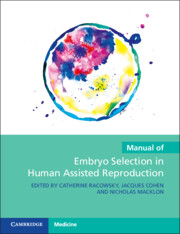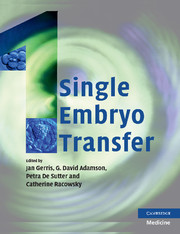20 results
Index
-
- Book:
- Manual of Embryo Selection in Human Assisted Reproduction
- Published online:
- 26 April 2023
- Print publication:
- 26 January 2023, pp 178-184
-
- Chapter
- Export citation

Manual of Embryo Selection in Human Assisted Reproduction
-
- Published online:
- 26 April 2023
- Print publication:
- 26 January 2023
Copyright page
-
- Book:
- Manual of Embryo Selection in Human Assisted Reproduction
- Published online:
- 26 April 2023
- Print publication:
- 26 January 2023, pp iv-iv
-
- Chapter
- Export citation
Preface
-
- Book:
- Manual of Embryo Selection in Human Assisted Reproduction
- Published online:
- 26 April 2023
- Print publication:
- 26 January 2023, pp ix-x
-
- Chapter
- Export citation
Contributors
-
- Book:
- Manual of Embryo Selection in Human Assisted Reproduction
- Published online:
- 26 April 2023
- Print publication:
- 26 January 2023, pp vi-viii
-
- Chapter
- Export citation
Epilogue
-
- Book:
- Manual of Embryo Selection in Human Assisted Reproduction
- Published online:
- 26 April 2023
- Print publication:
- 26 January 2023, pp 177-177
-
- Chapter
- Export citation
Contents
-
- Book:
- Manual of Embryo Selection in Human Assisted Reproduction
- Published online:
- 26 April 2023
- Print publication:
- 26 January 2023, pp v-v
-
- Chapter
- Export citation
Chapter 1 - A Brief Outline of the History of Human In-Vitro Fertilization
-
-
- Book:
- In-Vitro Fertilization
- Published online:
- 09 June 2018
- Print publication:
- 14 June 2018, pp 1-7
-
- Chapter
- Export citation
Preface
-
- Book:
- Single Embryo Transfer
- Published online:
- 18 December 2009
- Print publication:
- 06 November 2008, pp xv-xviii
-
- Chapter
- Export citation
Section 3 - Controversies
-
- Book:
- Single Embryo Transfer
- Published online:
- 18 December 2009
- Print publication:
- 06 November 2008, pp 211-288
-
- Chapter
- Export citation
Section 1 - Preliminaries
-
- Book:
- Single Embryo Transfer
- Published online:
- 18 December 2009
- Print publication:
- 06 November 2008, pp 1-50
-
- Chapter
- Export citation
Index
-
- Book:
- Single Embryo Transfer
- Published online:
- 18 December 2009
- Print publication:
- 06 November 2008, pp 289-305
-
- Chapter
- Export citation
Single Embryo Transfer - Half title page
-
- Book:
- Single Embryo Transfer
- Published online:
- 18 December 2009
- Print publication:
- 06 November 2008, pp i-ii
-
- Chapter
- Export citation
Section 2 - Clinical aspects
-
- Book:
- Single Embryo Transfer
- Published online:
- 18 December 2009
- Print publication:
- 06 November 2008, pp 51-210
-
- Chapter
- Export citation
Copyright page
-
- Book:
- Single Embryo Transfer
- Published online:
- 18 December 2009
- Print publication:
- 06 November 2008, pp iv-iv
-
- Chapter
- Export citation
Contributors
-
-
- Book:
- Single Embryo Transfer
- Published online:
- 18 December 2009
- Print publication:
- 06 November 2008, pp ix-xii
-
- Chapter
- Export citation

Single Embryo Transfer
-
- Published online:
- 18 December 2009
- Print publication:
- 06 November 2008
17 - Whatis the optimum day of transfer for single embryo transfer? Success rates, monozygotic twinning and epigenetic issues
- from Section 3 - Controversies
-
-
- Book:
- Single Embryo Transfer
- Published online:
- 18 December 2009
- Print publication:
- 06 November 2008, pp 213-222
-
- Chapter
- Export citation
Contents
-
- Book:
- Single Embryo Transfer
- Published online:
- 18 December 2009
- Print publication:
- 06 November 2008, pp v-viii
-
- Chapter
- Export citation
Foreword
-
- Book:
- Single Embryo Transfer
- Published online:
- 18 December 2009
- Print publication:
- 06 November 2008, pp xiii-xiv
-
- Chapter
- Export citation



